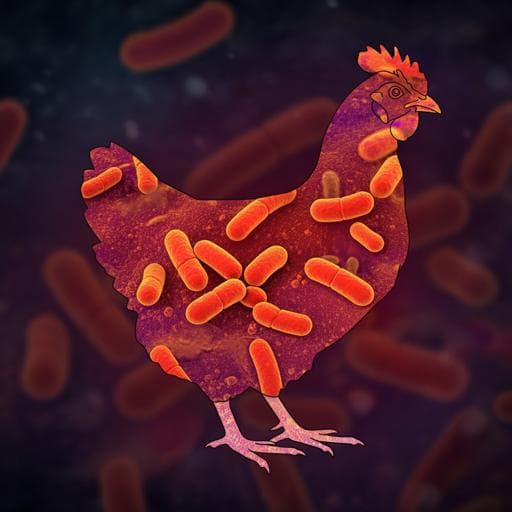
Food Science and Technology
Using stochastic dynamic modelling to estimate the sensitivity of current and alternative surveillance program of Salmonella in conventional broiler production
O. O. Apenteng, M. E. Arnold, et al.
Discover groundbreaking insights into Salmonella surveillance in Danish broiler production! This research conducted by Ofosuhene O. Apenteng, Mark E. Arnold, and Håkan Vigre reveals how enhanced testing methods can significantly increase the detection of infections in parent flocks within weeks.
~3 min • Beginner • English
Introduction
In Denmark, human salmonellosis rose rapidly in the late 1980s due to spread of Salmonella in broiler chickens, prompting a surveillance and control program aligned with EU legislation. The production system is organized as a pyramid from grandparent stock to broilers, with continuous environmental sampling (boot swabs and dust) at parent flocks, hatcheries, and broiler flocks. Despite EU recognition of Salmonella-free status since 2018, environmental pressure persists and some parent and broiler flocks become infected annually. Infected parent flocks can vertically transmit Salmonella to broiler flocks, and field experience indicates vertically infected broiler flocks are often detected before the parent flock is identified as positive. When zoonotic strains are detected, flocks and, where applicable, eggs are destroyed; however, there is uncertainty about how long a parent flock has been infected prior to detection, complicating decisions on egg destruction (one week vs. up to three weeks of eggs at the hatchery). The study aims to provide decision support by estimating: (i) the likelihood an infected parent flock is detected within three weeks after infection (the time eggs remain in hatcheries), (ii) the likelihood a vertically infected broiler flock is detected in the broiler monitoring program, and (iii) the effect of enhanced environmental sampling in parent flocks on time to detection. The approach combines dynamic transmission modelling in flocks with prevalence-dependent test sensitivity for environmental sampling and integrates uncertainty via stochastic modelling.
Literature Review
The work builds on established epidemic modelling frameworks (SIR/SI models) originating from Kermack and McKendrick and related adaptations to poultry Salmonella transmission. Prior studies quantified within-flock transmission for Salmonella Enteritidis and other serovars, showing variability in transmission rates between strains and production systems. Environmental sampling methodology and its prevalence-dependent sensitivity have been characterized in UK layer flocks, providing parameterized relationships for boot swab and dust sample sensitivity used here. Previous evaluations of sampling methods in broiler flocks and the role of environmental and management factors in Salmonella dynamics inform assumptions and parameter choices. The authors note that parameters derived largely from S. Enteritidis transmission studies may not generalize fully to other serovars (e.g., S. Typhimurium, monophasic variants), and farm-level heterogeneity can influence spread and detection.
Methodology
- Framework: Stochastic dynamic compartment modelling of within-flock Salmonella transmission combined with a prevalence-dependent environmental sampling sensitivity model. Separate models were developed for parent (multiplication) flocks and broiler flocks.
- Transmission model (parent flocks): SI model with no recovery and daily time steps. Infected birds progress through 21 infected-age compartments (I1 to I21) to represent declining infectiousness over time since infection. Homogeneous mixing is assumed. Force of infection each day is proportional to the sum over infected-age compartments of βi × Ii, scaled by susceptible fraction. A 1-day latent period before infectiousness is assumed.
- Parameters: Declining infectiousness βi based on Thomas et al. (S. Enteritidis); β1 ≈ 0.470 with subsequent daily decline to β21 ≈ 0.022. Rate of decline of environmental infectiousness γ ≈ 0.170 day−1. Movement between infected compartments δ = 1 day−1. The model yields daily prevalence from day 1 to day 21 post-introduction.
- Scenarios (parent flocks): Flock sizes N = 6000 and 12,000 hens; initial seeding with 10 or 100 infected hens to represent low/high introduction levels.
- Surveillance protocols (parent flocks): Current program samples weekly: 2 pairs of boot swabs pooled into one sample; alternatives include 5 pairs of boot swabs (analyzed as two pools) or 2 boot pairs plus 1 dust sample. Sampling structures align with Danish Veterinary and Food Administration proposals and broiler sampling practices.
- Prevalence-dependent sensitivity: The probability an environmental sample tests positive depends on flock prevalence via a logistic-type function with intercept α and slope ρ (parameters derived from UK layer studies). Sensitivities for different sampling combinations (number of boot swabs, inclusion of dust) are computed using these relationships.
- Weekly detection probability: For any introduction day t (1–7 relative to first weekly sample), the probability of detecting within three consecutive weekly samplings is computed as 1 − [(1 − Sen_t)(1 − Sen_{t+7})(1 − Sen_{t+14})], where Sen_day is the sensitivity on that day given the modelled prevalence.
- Uncertainty quantification: Monte Carlo simulation with 1001 iterations. Uncertain parameters: transmission rate β ~ N(0.47, 0.105), environmental decay γ ~ N(0.17, 0.039), sensitivity function parameters ρ ~ N(10.65, 3.765) and α ~ N(−1.53, 0.81). For each iteration, stochastic draws of parameters feed the transmission and sensitivity models to produce distributions of weekly and three-week detection probabilities; 95% confidence intervals taken as 2.5th and 97.5th percentiles.
- Broiler flock model: Population size 40,000 birds; initial single infected chick at placement. Transmission rate assumed 1.15 (95% CI 0.76–1.75). Environmental sampling at days 16 and 26 post-placement using five pairs of boot swabs. The same prevalence-dependent sensitivity framework and Monte Carlo procedure are applied over a 35-day grow-out.
- Implementation: Models coded in R using mc2d for Monte Carlo. Outputs include time-varying sensitivity curves (days 1–21 for parents; days 1–35 for broilers) and detection probability summaries for current and alternative sampling strategies.
Key Findings
- Detection sensitivity increases over time post-introduction as within-flock prevalence rises; however, uncertainty bands are wide early after introduction due to uncertainty in transmission and sensitivity parameters.
- Parent flocks (N ≈ 6000): Estimated likelihood of classifying a flock as positive at the first weekly sampling (days 1–7 after introduction) and within three weeks depends strongly on sampling intensity and initial seeding level (Table 2):
• Initial 10 infected hens:
- 2 boot swabs: median 18% (95% CI 4–54) at 1 week; 51% (13–97) within 3 weeks.
- 2 boot swabs + 1 dust: 27% (5–91) at 1 week; 68% (17–100) within 3 weeks.
- 5 boot swabs: 64% (20–98) at 1 week; 97% (50–100) within 3 weeks.
• Initial 100 infected hens:
- 2 boot swabs: 23% (6–63) at 1 week; 95% (40–100) within 3 weeks.
- 2 boot swabs + 1 dust: 32% (6–94) at 1 week; 98% (43–100) within 3 weeks.
- 5 boot swabs: 73% (24–99) at 1 week; 100% (70–100) within 3 weeks.
- Increasing weekly sampling in parent flocks from 2 to 5 boot swabs markedly improves early detection probability (within first 3 weeks), particularly when initial seeding is low (10 hens).
- Broiler flocks: Assuming a single infected chick at placement (N = 40,000), the likelihood of detecting infection in the monitoring program (sampling at days 16 and 26) is estimated at 100% (95% CI 99–100), indicating near-certain detection before slaughter.
- Model outputs align with field observations where vertically infected broiler flocks were detected before corresponding parent flocks tested positive.
Discussion
The study addresses three key questions: (i) how likely current surveillance detects parent-flock infections within three weeks of introduction, (ii) how likely vertically infected broiler flocks are detected, and (iii) how enhanced sampling affects time-to-detection. The results suggest that current weekly sampling with two pooled boot swabs can miss early infections in parent flocks, especially when initial seeding is low, allowing several weeks of egg production with potential vertical transmission. Increasing weekly sampling to five boot swabs or adding dust samples substantially increases early detection probability. For broiler flocks, detection likelihood is extremely high even with minimal initial infection, supporting confidence that vertically transmitted infections will be identified before slaughter. The modelling framework, which links within-flock transmission dynamics with prevalence-dependent environmental sampling sensitivity and quantifies uncertainty via Monte Carlo simulation, provides decision support for optimizing surveillance schedules. The authors discuss uncertainties and generalizability: transmission rates vary across Salmonella serovars and farms; parameters were primarily derived from S. Enteritidis and UK layer studies; and the model assumes homogeneous mixing and no recovery. Despite these limitations, the relative comparison between sampling strategies is robust and useful for policy refinement. The approach is generalizable to other infectious disease surveillance programs by jointly simulating spread and sampling.
Conclusion
The study develops and applies a stochastic dynamic modelling framework to evaluate the sensitivity of current and alternative Salmonella surveillance strategies in Danish broiler production. Key contributions include: (1) quantifying how detection probability in parent flocks depends on time since introduction, initial seeding, and sampling intensity; (2) demonstrating that increasing weekly sampling from two to five boot swabs greatly improves early detection within three weeks; and (3) showing that broiler monitoring is highly sensitive (≥99% detection) even with a single initially infected chick. These insights support evidence-based adjustments to parent-flock surveillance and decision-making regarding egg destruction during outbreaks. Future research should refine strain-specific transmission parameters, incorporate farm-level heterogeneity, validate prevalence–sensitivity relationships specifically for parent and broiler environments, and assess cost-effectiveness of alternative sampling schedules.
Limitations
- Transmission parameters primarily derived from Salmonella Enteritidis may not generalize to other serovars (e.g., S. Typhimurium, monophasic variants) with different transmission dynamics.
- Farm-to-farm variability in management and biosecurity, which can markedly affect transmission, was not explicitly modelled; results reflect average performance rather than farm-specific predictions.
- Assumptions include homogeneous mixing, no recovery (persistent infection state), a 1-day latent period, and 100% specificity (no false positives due to confirmatory testing), which may not capture all real-world complexities.
- Prevalence-dependent sensitivity functions are based on UK layer flock studies; differences between layer and parent/broiler environments could affect applicability.
- Early-phase detection estimates have wide confidence intervals due to uncertainty in both transmission and sensitivity parameters.
- The alternative sampling strategies’ operational feasibility and costs were not modelled; only detection performance was assessed.
Related Publications
Explore these studies to deepen your understanding of the subject.







